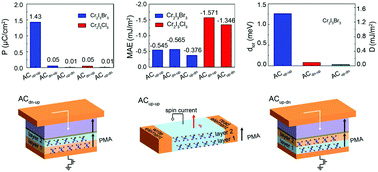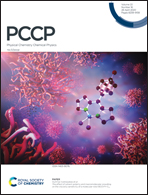Electronic structure, magnetic anisotropy and Dzyaloshinskii–Moriya interaction in Janus Cr2I3X3 (X = Br, Cl) bilayers†
Abstract
Two-dimensional (2D) layers with a tunable electronic structure and magnetic properties have attracted much attention due to their unique characteristics and practical applications. Here, the electronic structure and magnetic properties of the 2D van der Waals Cr2I3X3 (X = Br, Cl) bilayers are investigated systematically by first-principles calculations. The Cr2I3X3 bilayers show the stacking-dependent magnetic ground state, where the band gap can be effectively tailored by the stacking and combination modes. In the Cr2I3Br3 (Cr2I3Cl3) bilayers, the electrostatic potential and electric polarization can be greatly affected by combination modes, which can be attributed to the parallel or antiparallel built-in electric fields between the monolayers. The Cr2I3X3 bilayers show a perpendicular magnetic anisotropy. The magnetic anisotropy energy of the Cr2I3Cl3 bilayer is larger than that of the Cr2I3Br3 bilayer, which can be attributed to the enhanced contribution of the hybridized I px and py orbitals of the Cr2I3Cl3 bilayer. Additionally, the Dzyaloshinskii–Moriya interaction of the Cr2I3Br3 bilayer can also be modulated by the combination modes. These results can boost the development of Janus 2D materials, which are useful in the design of multifunctional spintronic devices.



 Please wait while we load your content...
Please wait while we load your content...